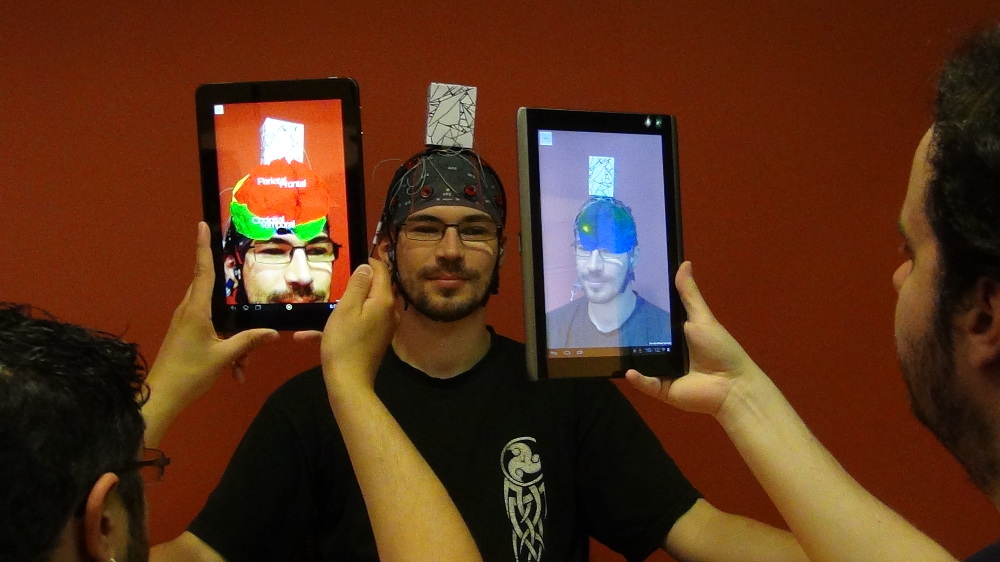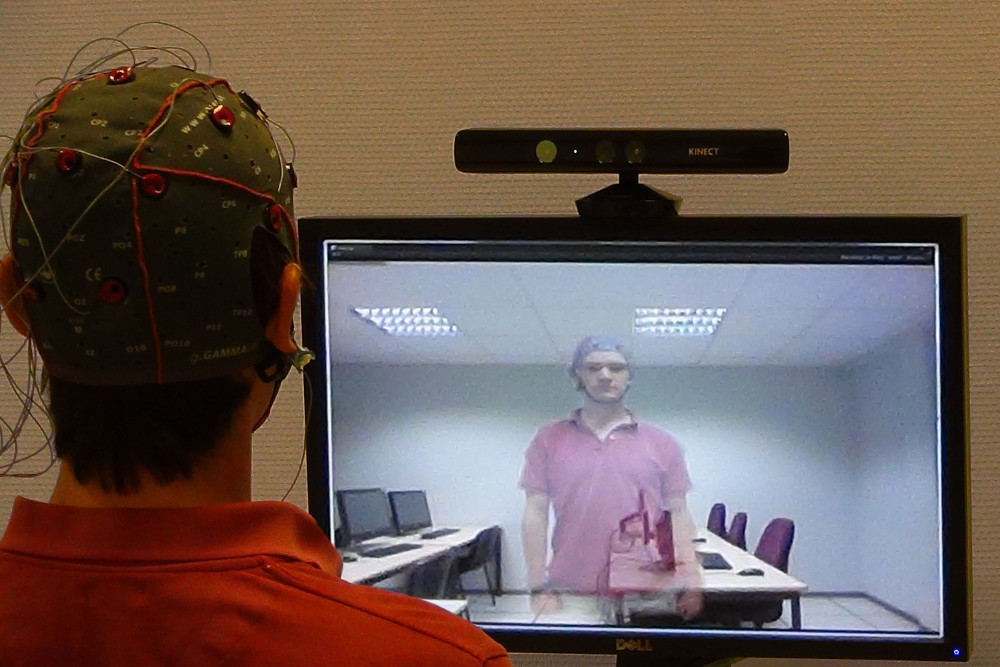Section: New Results
Brain-Computer Interfaces
Novel Usages of BCI
Mind-Window: Real-Time Brain Activity Visualization Using Tablet-Based Augmented Reality and EEG for Single or Multiple Users, Anatole Lécuyer, Jonathan Mercier, Maud Marchal
|
We introduced a novel approach, called the “Mind-Window”, for real-time visualization of brain activity [33] . The Mind-Window enables one or multiple users to visualize the brain activity of another person as if his/her skull was transparent. Our approach relies on the use of multiple tablet PCs that the observers can move around the head of the observed person wearing an electroencephalography cap (EEG). A 3D virtual brain model is superimposed to the head of the observed person using augmented reality by tracking a 3D marker placed on top the head. The EEG cap records the electrical fields emitted by the brain, and they are processed in real-time to update the display of the virtual brain model. Several visualization techniques are proposed such as an interactive cutting plane which can be manipulated with touch-based inputs on the tablet. The Mind-Window approach could be used for medical applications, e.g. by providing a simple way for physicians to diagnose and observe brain activity of patients. Teachers could also use our system to teach brain anatomy/activity and EEG features, e.g., electrodes localization, electrical patterns, etc. Finally, video conferences or video games could be “brain-augmented”, making use of the Mind-Window for entertainment purposes.
B-C-Invisibility Power: Optical Camouflage Based on Mental Activity in Augmented Reality, Anatole Lécuyer, Jonathan Mercier, Maud Marchal
|
In the context of the ANR project HOMO-TEXTILUS which focuses on the design of novel "smart clothes", we introduced a kind of "invisibility cloak": an interactive approach for using Brain-Computer Interfaces for controlling optical camouflage called "B-C-Invisibility power”. We proposed to combine augmented reality and BCI technologies to design a system which somehow provides the "power of becoming invisible” [32] . Our optical camouflage is obtained on a PC monitor combined with an optical tracking system. A cut out image of the user is computed from a live video stream and superimposed to the prerecorded background image using a transparency effect. The transparency level is controlled by the output of a BCI, making the user able to control her invisibility directly with mental activity. The mental task required to increase/decrease the invisibility is related to a concentration/relaxation state. Results from a preliminary study based on a simple video-game inspired by the Harry Potter universe could notably show that, compared to a standard control made with a keyboard, controlling the optical camouflage directly with the BCI could enhance the user experience and the feeling of “having a super-power”.
BCI Methodology and Techniques
A methodological framework for applications combining BCI and videogames, Anatole Lécuyer
We have proposed a user-centered methodological framework [41] to guide design and evaluation of applications based on Brain-Computer Interface (BCI). Our framework is based on the contributions of ergonomics to ensure that these applications are well suited for end-users. It provides methods, criteria and metrics to perform the phases of the human-centered design process aiming to understand the context of use, specify the user needs and evaluate the solutions in order to define design choices. Several ergonomic methods (e.g., interviews, longitudinal studies, user based testing), objective metrics (e.g., task success, number of errors) and subjective metrics (e.g., mark assigned to an item) are suggested to define and measure the usefulness, usability, acceptability, hedonic qualities, appealingness, emotions related to user experience, immersion and presence to be respected. The benefits and contributions of our user centred framework for the ergonomic design of videogames based on BCI were also discussed.
This work was done in collaboration with Fabien Lotte (Inria team POTIOC).
Feasibility and specificity of simultaneous EEG and fMRI, Marsel Mano, Lorraine Perronnet, Jussi Lindgren, Anatole Lécuyer
In the field of fMRI, Arterial Spin Labeling (ASL) imaging relies on control and label radio-frequency pulses. This generates alternate gradient patterns as well as higher specific absorption rate (SAR). To date, only a few studies have addressed the issue of connecting EEG signal to ASL perfusion. Furthermore, previous studies have shown reduced blood-oxygen-level dependent (BOLD) signal-to-noise ratio (SNR) in the presence of EEG. ASL being a low SNR technique, the aim of this study was to assess ASL-EEG at 3T in terms of safety as well as EEG and magnetic resonance signal quality. Our experimental results show that ASL-EEG can be safely performed [20] [38] . Standard ASL acquisitions generated more than 2.5-fold SAR increase compared to a standard BOLD echo planar imaging sequence. This corresponded to up to 4°C temperature increase on the bundle, yet not exceeding 36°C. Gradient artifact correction of the EEG signal by average artifact subtraction was generally good for BOLD-EEG and ASL-EEG. However, residual gradient artifacts affecting 1% of the pulsed ASL-EEG data have to be considered. Further research is needed to understand the artifact variability and to develop an appropriate correction strategy. No residual artifacts were observed for alternating control and label pulses ASL-EEG. Neither a change of the number of reference volumes for artifact subtraction nor an independent component analysis could help tackle this gradient artifact correction issue. Regarding magnetic resonance imaging, a 20% loss in SNR was observed when compared to acquisitions performed without EEG. Taken together our results suggest that EEG and ASL MRI can be simultanously combined for the purpose of real-time experiments which could for instance be envisionned in our HEMISFER project.
This work was done in collaboration with VISAGES team.



